Integrate Zoho Books with Zoho CRM
When you integrate Zoho Books with Zoho CRM, you can view and manage customer and accounting information in one place. This integration improves collaboration between sales and finance teams in your business, allowing them to track deals, create quotes, and invoices without switching between applications.
Benefits of the Integration
- Capture all customer information in one place, so you can work on the same information at hand in both the apps.
- View customer’s key accounting metrics like sales information and outstanding receivables directly from Zoho CRM.
- Sync transactions between both apps.
- Automate workflows, like creating an invoice when a deal is won.
Set up the Integration
Prerequisites:
- You can integrate with a Zoho CRM organization only if it’s in the Professional plan or higher.
- If multi-currency is enabled in Zoho CRM, ensure that the base currency in Zoho CRM matches the one set in Zoho Books.
Insight: When you integrate, the following data from Zoho Books will be shared with Zoho CRM:
- Your organization name, email address, and your country.
- All your users’ details.
To set up the CRM integration from Zoho Books:
Go to Settings on the top right corner of the page.
Select Zoho Apps under Integrations.
In the Zoho Apps page, click Connect next to Zoho CRM.

In the Connect to Zoho CRM page, click Select Organization in the Zoho CRM Organization section.
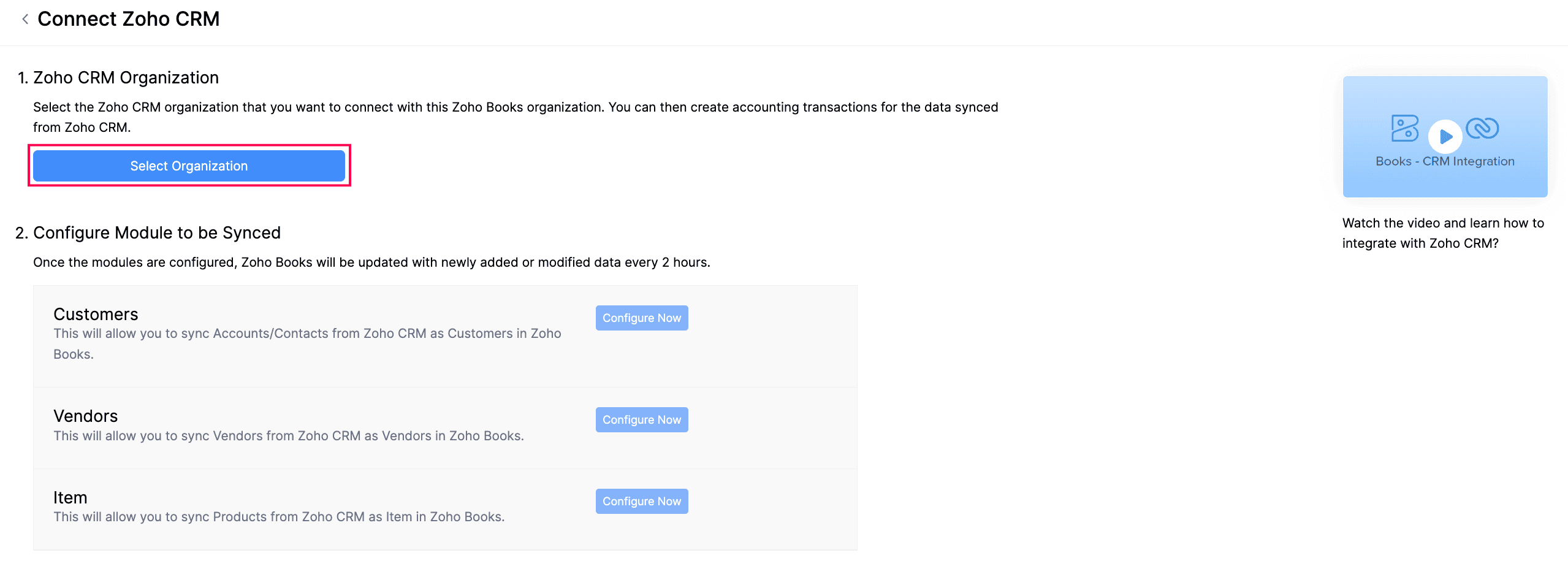
In the Connect Zoho CRM pop-up, select the required Organization, and click Save.
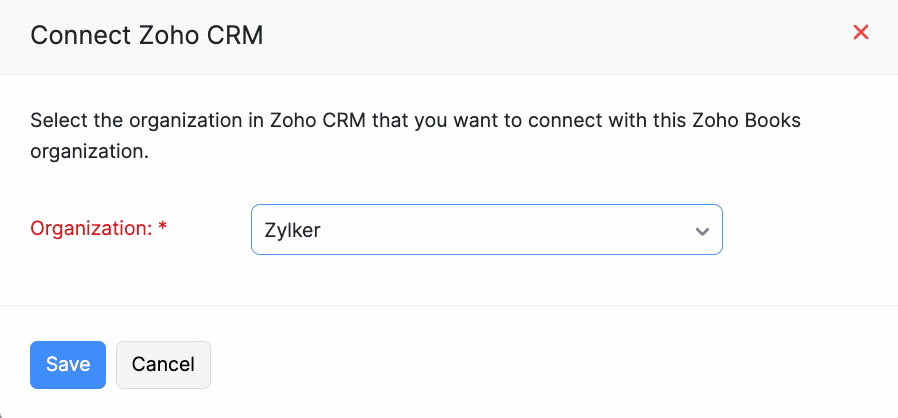
A two-way sync will be set up, which means that data will be fetched from Zoho CRM into Zoho Books and vice-versa.
Note: If you want to integrate multiple Zoho Books organizations with a Zoho CRM organization, email us at support@zohobooks.com, and we’ll assist you with the set up. However, this will be a one-way sync, which means that data will be fetched only from Zoho CRM into Zoho Books and transaction modules will not be synced during this process.
Configure the Modules to be Synced
Once you set up the integration, you can configure the modules to sync between Zoho Books and Zoho CRM. To do this:
- Go to Settings.
- Select Zoho Apps under Integrations & Marketplace.
- In the Zoho Apps page, click Show Details next to Zoho CRM.
- In the Configure Module to be Synced section, click Configure Now next to the required module you want to sync from Zoho CRM into Zoho Books.
You can sync data for the following modules from Zoho CRM into Zoho Books:
Sync Customers
To sync customer data from Zoho CRM into Zoho Books:
Go to Settings.
Select Zoho Apps under Integrations & Marketplace.
In the Zoho Apps page, click Show Details next to Zoho CRM.
In the Configure Module to be Synced section, click Configure Now next to Customers.
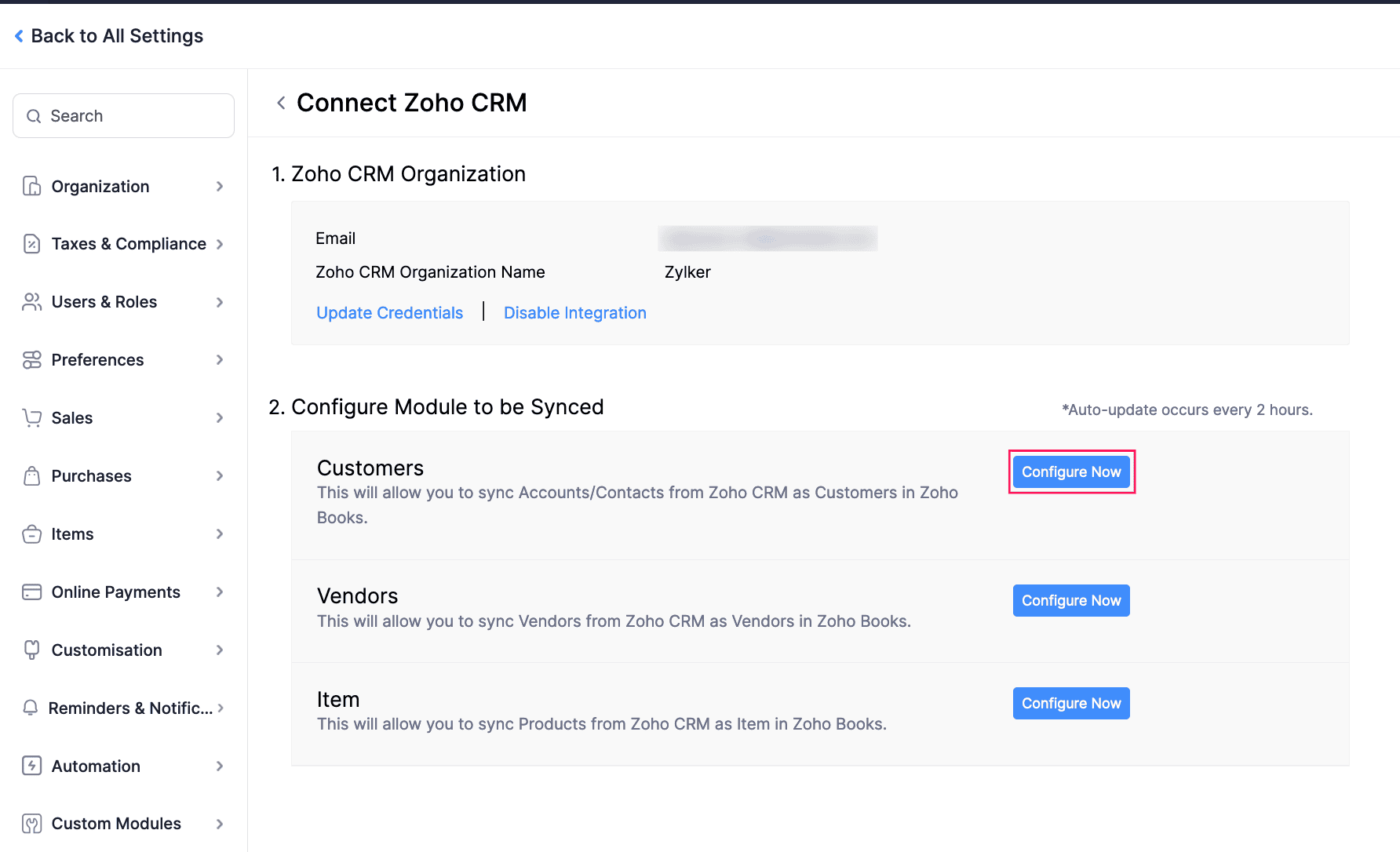
In the next page, configure the following preferences:
Select Module in Zoho CRM: Select the module you want to sync between Zoho CRM and Zoho Books.
- Accounts: The Accounts in Zoho CRM will be fetched as Customers in Zoho Books with the Customer Type set as Business.
- Contacts: The Contacts in Zoho CRM will be fetched as Customers in Zoho Books with the Customer Type set as Individual.
- Accounts & their Contacts: The Accounts and associated Contacts in Zoho CRM will be fetched as Customers and Contact Persons in Zoho Books. Check Include contacts that are not associated to any accounts in Zoho CRM to sync contacts that are not associated with an account in Zoho CRM. These contacts will be fetched as Customers in Zoho Books with the Customer Type set as Individual.

Select the extent of sync: Choose how you want to sync records between both the apps.
- Fetch from CRM: The records in Zoho CRM will only be fetched into Zoho Books. No Zoho Books records will be fetched into Zoho CRM. However, any records already pushed to Zoho CRM will remain unaffected.
- Sync both ways: The records will be synced from Zoho CRM to Zoho Books and vice-versa, in which Zoho CRM records will be fetched first.

Insight: If you choose two-way sync, a Customer with Customer Type set as Business in Zoho Books will sync with the Accounts module in Zoho CRM, and a Customer with Customer Type set as Individual in Zoho Books will sync with the Contacts module in Zoho CRM.
- Choose how to handle duplicate customers: When you sync records between Zoho CRM and Zoho Books, there might be a record in Zoho CRM that is already present in Zoho Books. To resolve this, duplicate records are identified by comparing Account Name in Zoho CRM and Customer Display Name in Zoho Books. Choose how you want to handle duplicate records during the sync:
- Clone: The duplicate record will be cloned, and will be available along with the existing record.
- Overwrite: The duplicate record will replace the existing record in Zoho Books.
- Skip: The duplicate record will not be synced, and the existing record will remain unchanged.

- Select the view to be synced: To sync specific records from Zoho CRM, you can create a view and sync that view into Zoho Books. If you choose to sync Accounts & their Contacts, you can select both the Account view and the Contact view to sync records.

- Map Fields: Match the fields in Zoho Books with the corresponding fields in Zoho CRM. Some fields are mapped automatically, while you must map the remaining fields manually. If certain fields from Zoho CRM can’t be mapped to the default Zoho Books fields, create custom fields in Zoho Books. These fields will appear during the mapping process.
Prerequisite: If you’ve enabled multi-currency in Zoho CRM, ensure that the base currency in Zoho CRM matches the base currency in Zoho Books before mapping the fields.
- Click Save and Sync to start the sync process, or click Save and Sync Later if you want to save the preferences now and sync the records later.
The customers will be synced in a while, based on chosen preferences. To check the status of the sync, click Check Status under the Customers section.
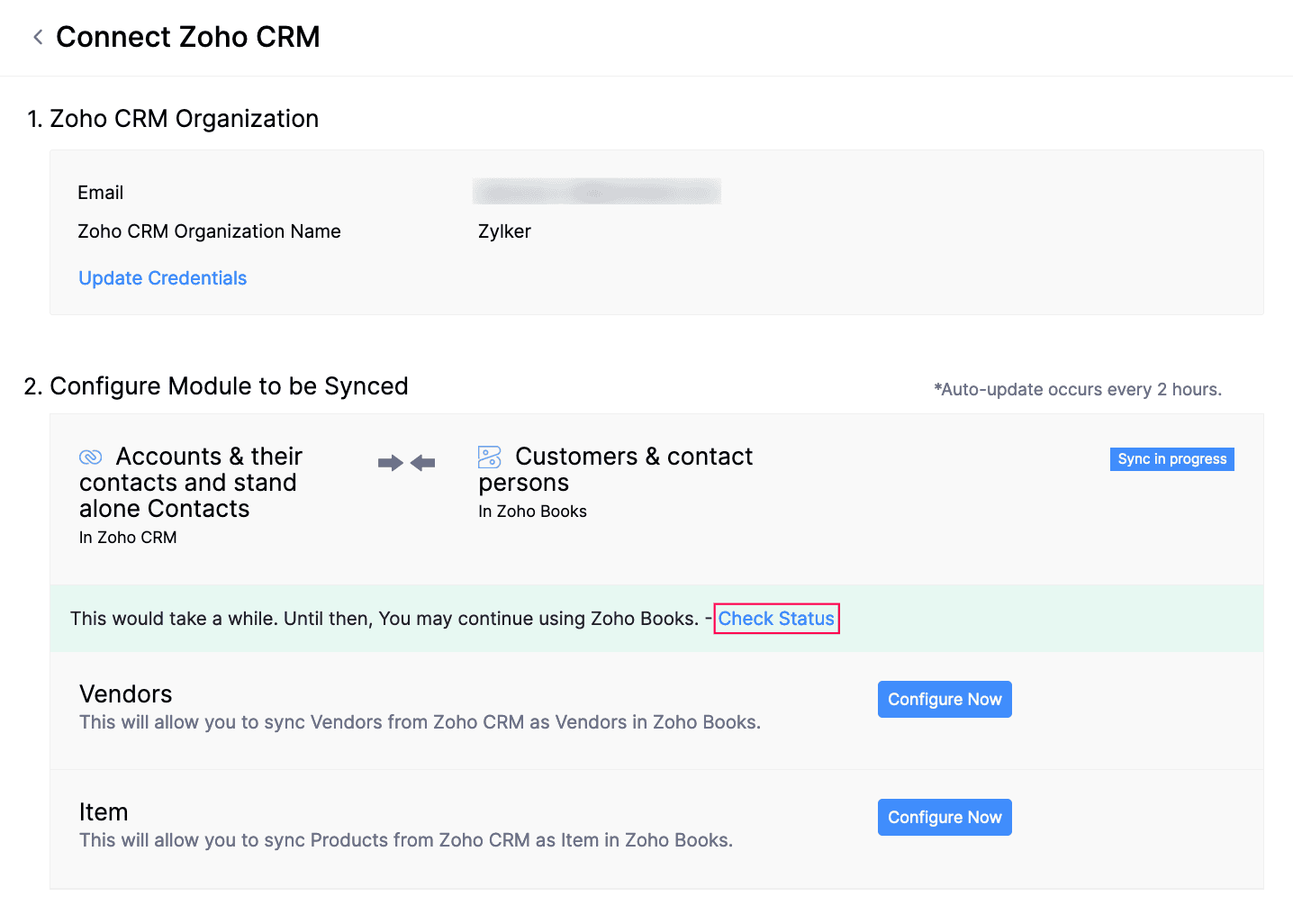
Sync Vendors
You can sync vendors into Zoho Books similar to how you’ve synced your customers.
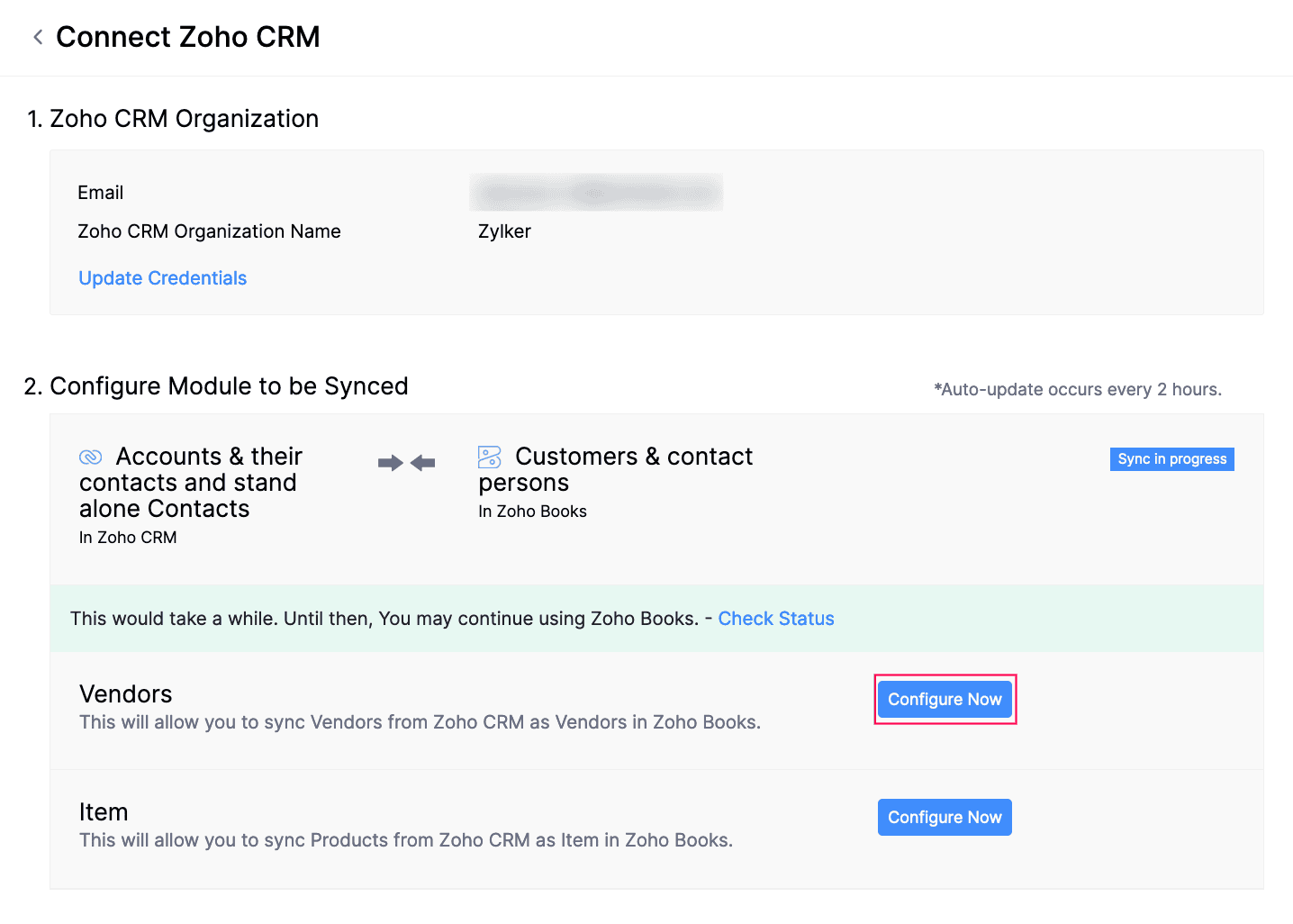
- Select the extent of sync: Choose whether you want to sync vendors only from Zoho CRM into Zoho Books or both ways.
- Choose how to handle duplicate vendors: Choose whether you want to clone, overwrite, or skip duplicate records during the sync.
- Select the view to be synced: To sync specific vendors, select the view in Zoho CRM you want to sync with Zoho Books.
- Map Fields: Match the fields in Zoho Books with the corresponding fields in Zoho CRM. You can also create custom fields in Zoho Books to match the fields in Zoho CRM, if required.
Once done, click Save and Sync to start the sync process, or click Save and Sync Later if you want to save the preferences now and sync the records later.
The vendors will be synced in a while, based on chosen preferences. To check the status of the sync, click Check Status under the Vendors section.
Sync Items
You can sync the Items in Zoho Books with the Products in Zoho CRM, similar to customers and vendors. To sync items:
Go to Settings.
Select Zoho Apps under Integrations & Marketplace.
In the Zoho Apps page, click Show Details next to Zoho CRM.
In the Configure Module to be Synced section, click Configure Now next to Items.
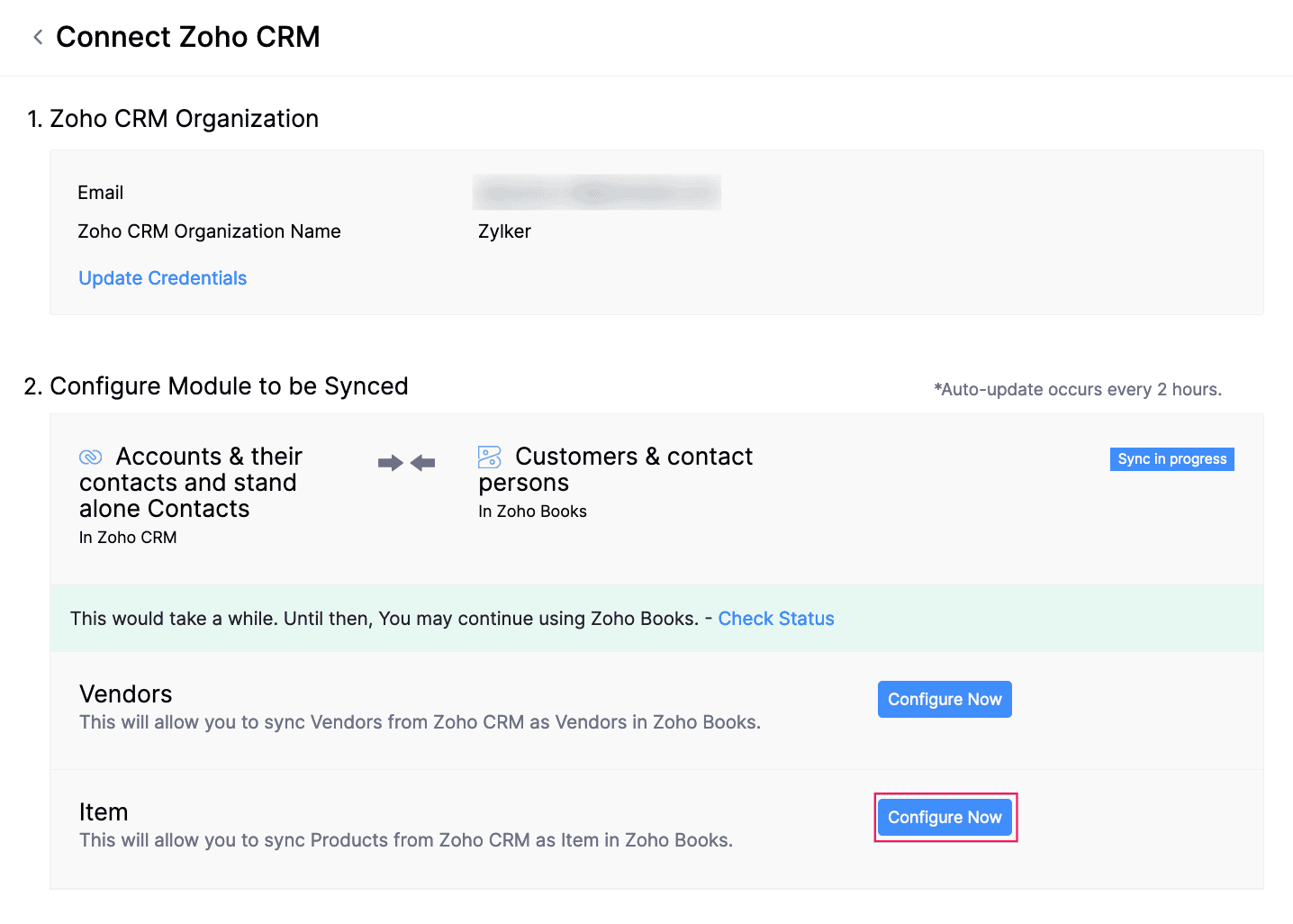
In the next page, configure the following preferences:
- Select the extent of sync: Choose how information flows between the two apps.
- Fetch from CRM: The products in Zoho CRM will only be fetched as Items into Zoho Books. No Zoho Books records will be fetched into Zoho CRM. However, any records already pushed to Zoho CRM will remain unaffected.
- Sync both ways: The Items from Zoho Books will be synced as Products into Zoho CRM, and vice-versa, in which records from Zoho Books will be fetched first.

- Choose how to handle duplicate items: If a record from Zoho CRM already exists in Zoho Books, syncing items will create a duplicate item in Zoho Books. To resolve this, duplicate records are identified by comparing either the Item Name or SKU in Zoho Books with the Product Code in Zoho CRM. From the dropdown below, choose whether to identify duplicate items by Name or SKU.
- Select the extent of sync: Choose how information flows between the two apps.
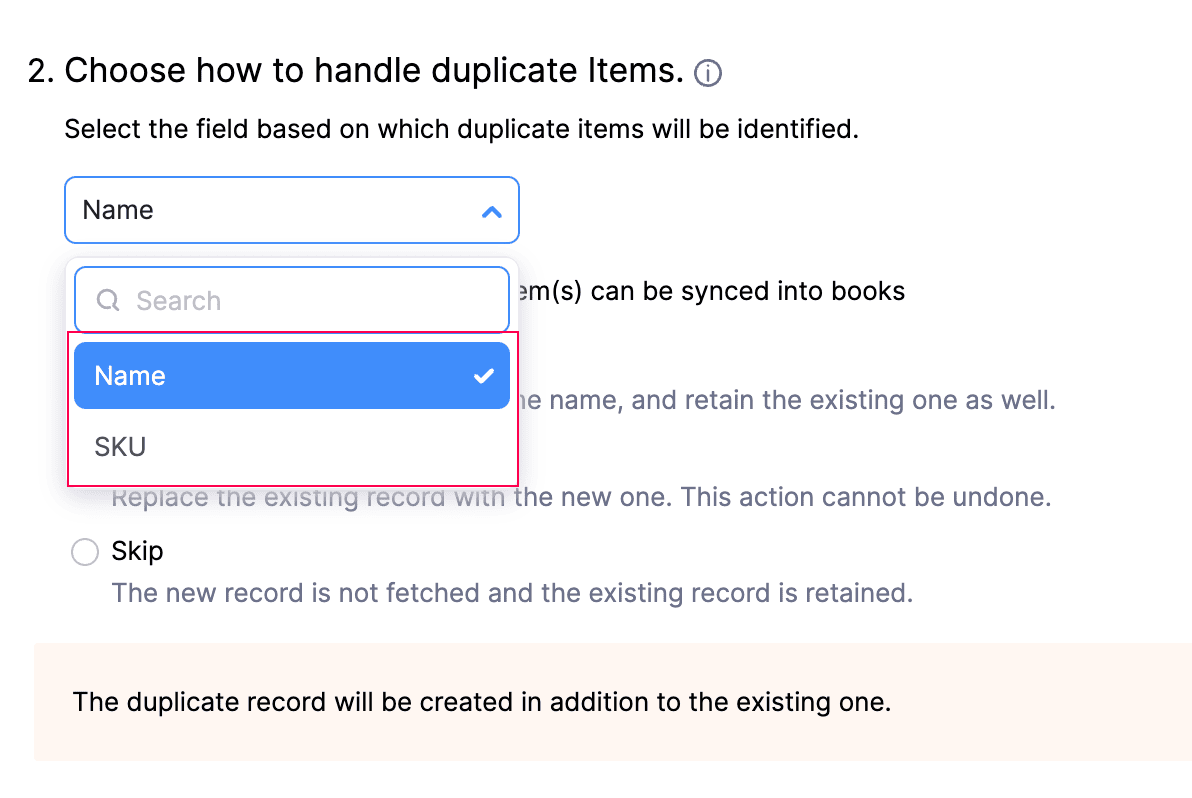
- If you select Name, you can choose to Clone, Overwrite, or Skip the duplicate item.
- Clone: The duplicate item will be cloned, and will be available along with the existing record.
- Overwrite: The duplicate item will replace the existing record in Zoho Books.
- Skip: The duplicate item will not be synced, and the existing record will remain unchanged.
- If you select SKU, you can choose to Overwrite, or Skip the duplicate Item.
- Select the view to be synced: To sync specific records from Zoho CRM into Zoho Books, you can create a view in Zoho CRM, add products, and sync the view. During the sync, click the click here to select a view option and select the required view in the Select a view dropdown.


- Map Fields: Match the fields in Zoho Books with the corresponding fields in Zoho CRM. You can also create custom fields in Zoho Books to match the fields in Zoho CRM, if required.
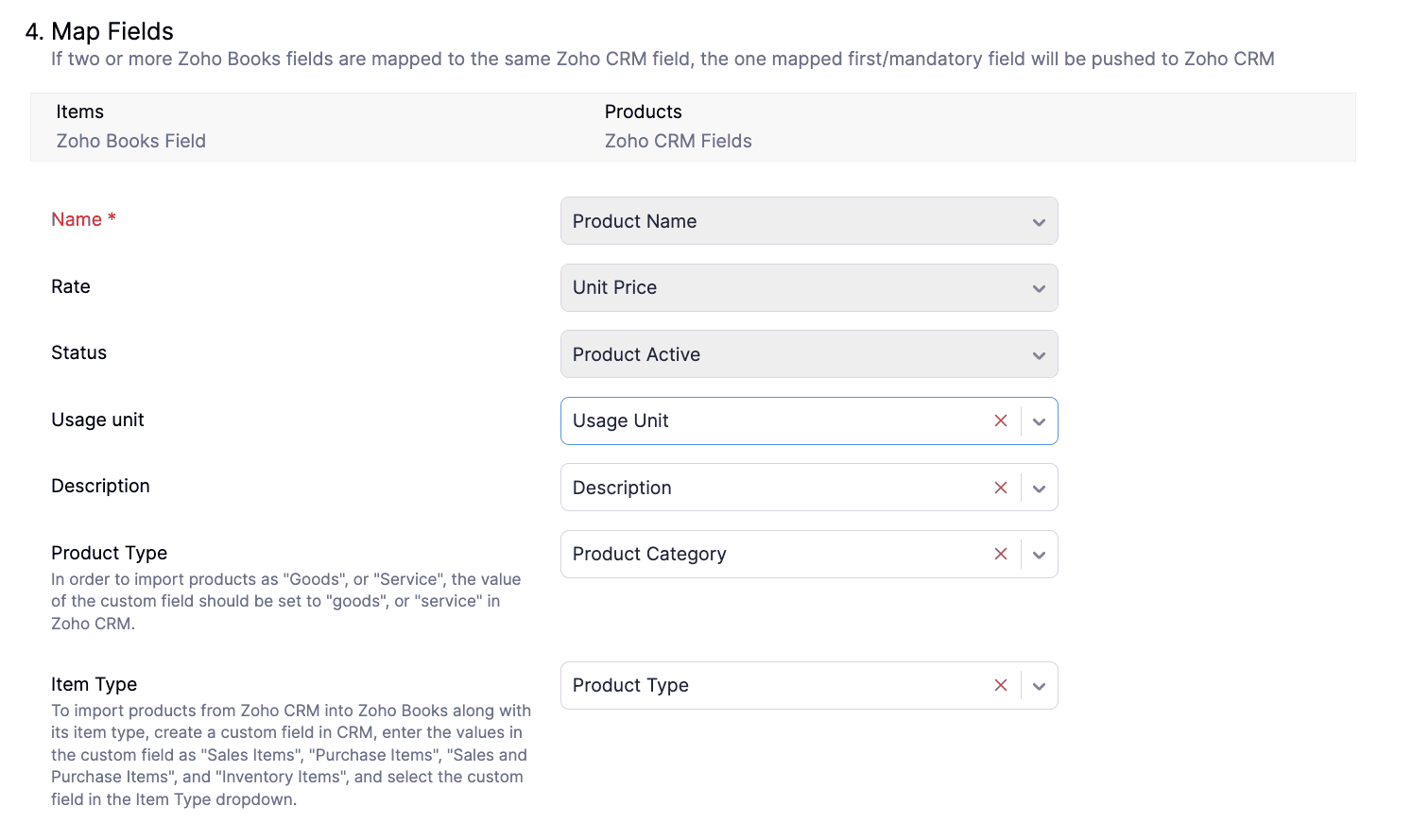
Note: The custom fields that you’ve added to templates other than the standard one in Zoho CRM will not be available in the Zoho CRM fields for mapping.
Note: If you chose to identify duplicate items by SKU in Zoho Books, you should map the SKU field in Zoho Books with the Product Code field in Zoho CRM. Additionally, make sure that the Product Name field is configured not to allow duplicate values. To do this, Go to Zoho CRM > Setup > Customization > Modules > Products > Layouts > Select a Layout > Product Information > Click the More icon next to the Product Name field and select Do not allow duplicate values.
Insight: If you want to classify the products in Zoho CRM as goods or services, create a custom field with Goods and Services. Then, map this custom field for the Product Type field in Zoho Books.
- Click Save and Sync to start the sync process, or click Save and Sync Later if you want to save the preferences now and sync the records later.
The items will be synced in a while, based on chosen preferences. To check the status of the sync, click Check Status under the Items section.
Sync Transaction Modules
Once you’ve synced customers, vendors, and items, you can sync transaction modules between Zoho Books and Zoho CRM. With this, Quotes, Invoices, Sales Orders, and Purchase Orders in Zoho Books can be accessed from Zoho CRM. Here’s how:
Go to Settings.
Select Zoho Apps under Integrations & Marketplace.
In the Zoho Apps page, click Show Details next to Zoho CRM.
In the Sync Transaction Modules section, click Enable.

Now, you can access these modules in the Zoho Finance module of Zoho CRM. Only the transactions created in this module in Zoho CRM will be synced to Zoho Books.
Insight: If you’ve created any custom fields for these transactions in Zoho Books, they’ll also appear in Zoho CRM.
Manage Users and Roles
Prerequisite: This section will be enabled only if you’ve synced all the transaction modules.
Once you’ve synced the transaction modules, you can grant permission to your users in Zoho CRM to view, create and edit the transactions. You can also provide approval permission for quotes. To do this:
Go to Settings.
Select Zoho Apps under Integrations & Marketplace.
In the Zoho Apps page, click Show Details next to Zoho CRM.
In the Manage Users and Roles section, click Manage Users.
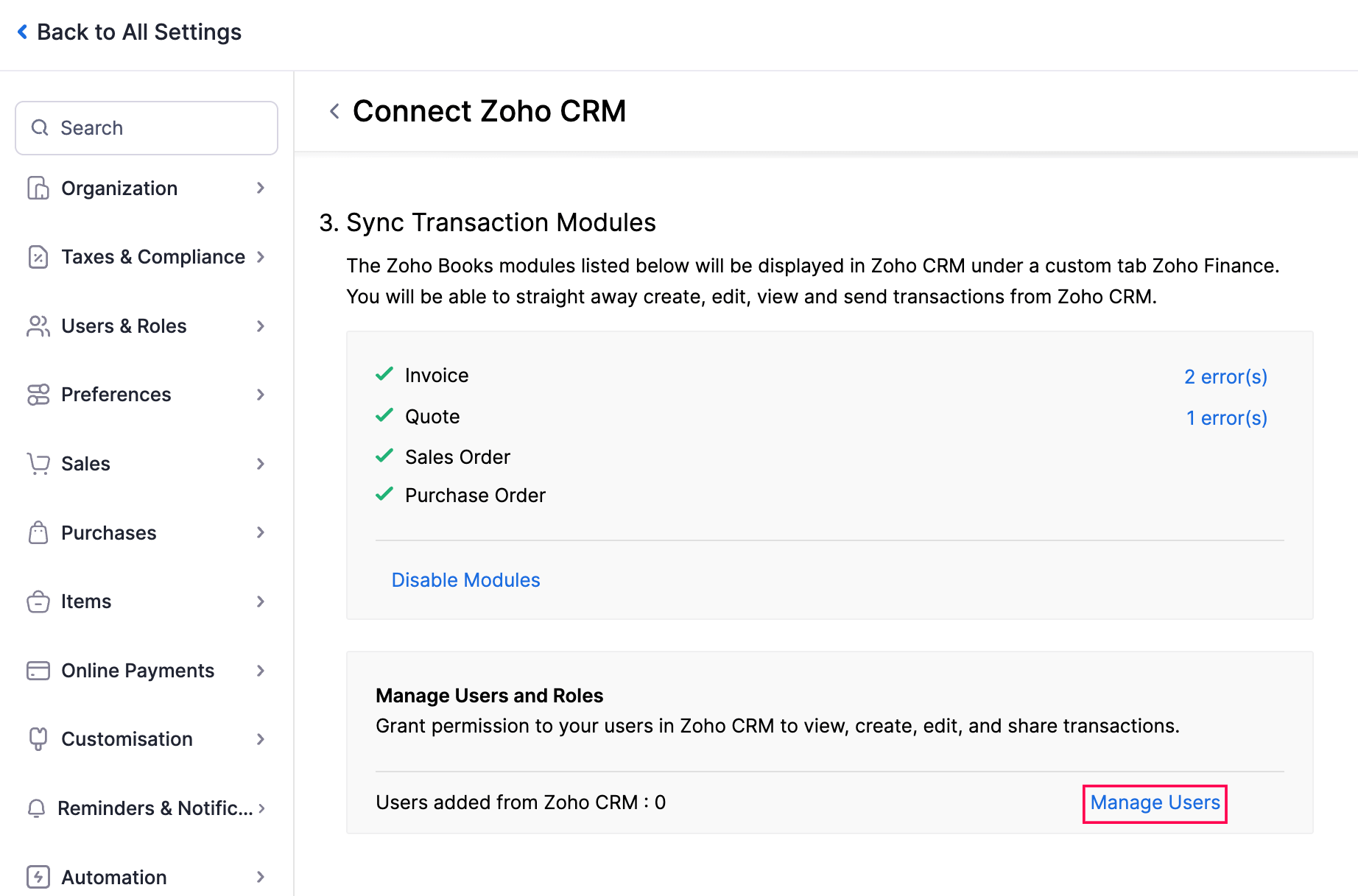
In the Manage Users from Zoho CRM pop-up, select the users and roles you want to grant permissions, and click Save.
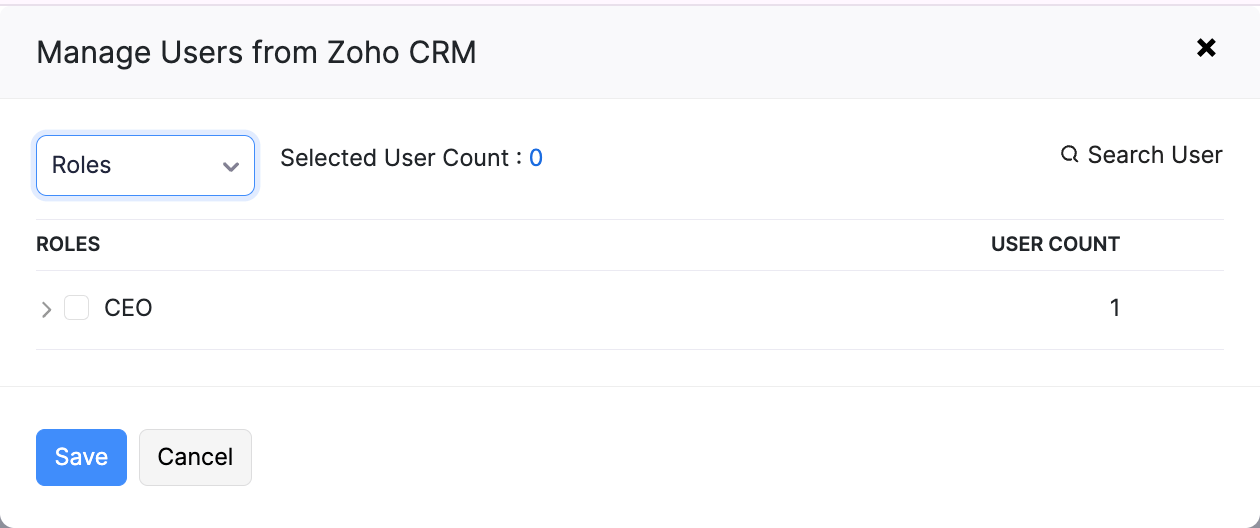
Note: The role of a Zoho CRM user will appear as Integration User (Zoho CRM) in your Zoho Books organization. To change their role to a Zoho Books user, go to Settings > Users & Roles > Users. Select the user, click Edit, choose a role from the Role dropdown, and click Save & Continue. Please note that you cannot undo this action.
Automate Based on Deal/Potential’s Stage
While setting up the integration, you can configure triggers to automate tasks in Zoho Books based on the deal or potential’s stage in Zoho CRM. For example, you can set up a trigger to automatically create a quote in Zoho Books whenever a potential is created in Zoho CRM.
Prerequisite: While syncing customers from Zoho CRM into Zoho Books, if you chose to sync Accounts & their Contacts, the deal in Zoho CRM must be associated with an account for the trigger to be automated. If you choose to sync Contacts, the deal must be associated with a contact.
To set up the triggers:
Go to Settings.
Select Zoho Apps under Integrations & Marketplace.
In the Zoho Apps page, click Show Details next to Zoho CRM.
In the Automate Based on Deal/Potential’s Stage section, click Change Preference.

In the pop-up that appears, select the required preference, and click Save.
The trigger will be set up. To view the status of this trigger:
Go to Reports on the left sidebar.
Select Activity Logs & Audit Trail under Activity.
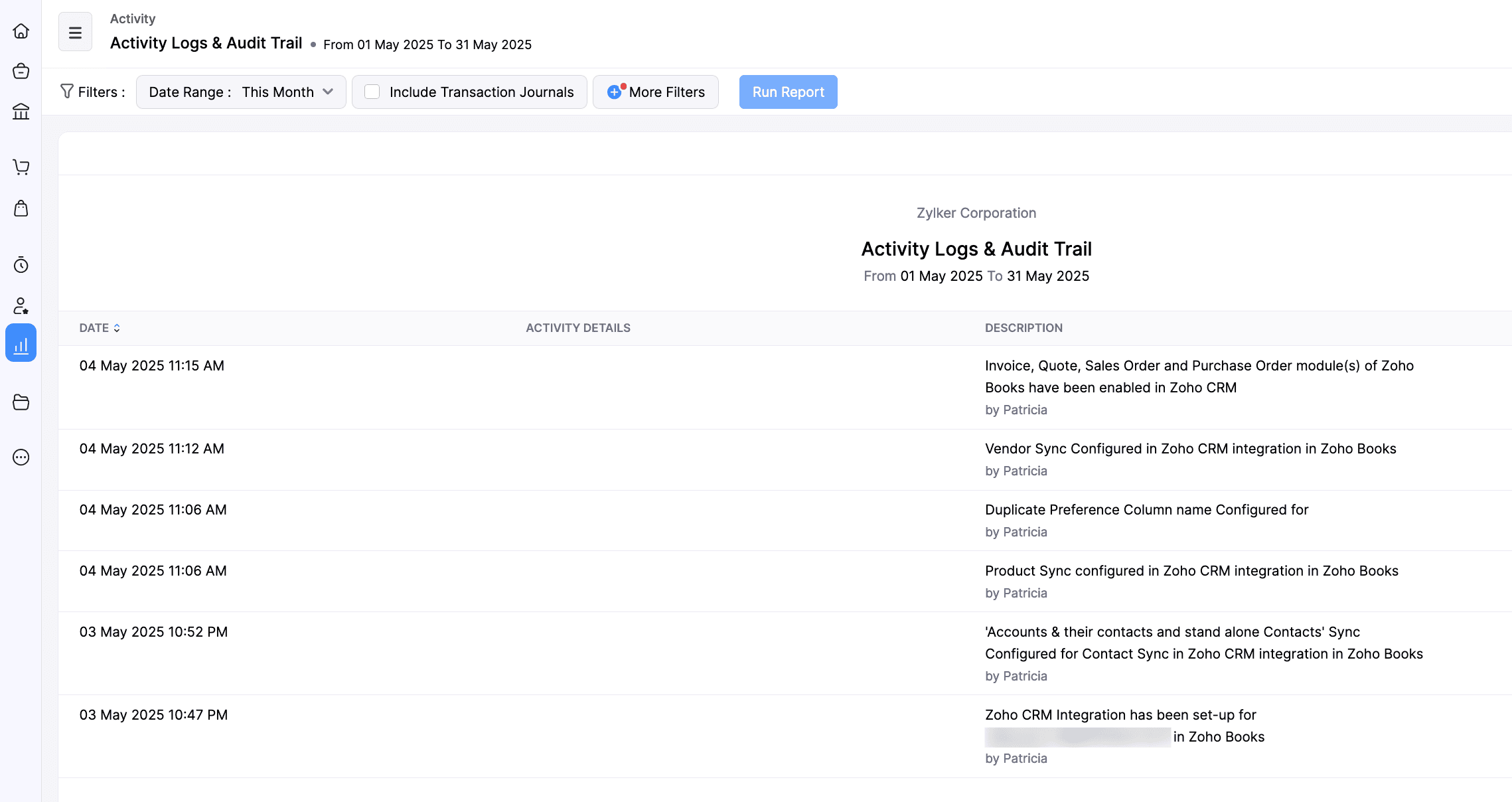
The report for the workflows executed during the integration will be displayed.
Quotes
You can choose the stages at which a quote should be created, accepted, or declined:
- Create Quote: Select the stage at which a quote should be created automatically in Zoho Books. The quote will be created in the Draft status.
- Approve Quote: Select the stage at which a quote should be approved automatically in Zoho Books. An invoice will be created based on your quote’s preference.
- Decline Quote: When a deal is lost and its status in Zoho CRM changes to Closed Lost, the corresponding quote will be marked as Declined.
Invoices
You can also automate invoice creation in Zoho Books based on the deal’s stage in Zoho CRM. When enabled, an invoice will be created in Zoho Books when a deal is won in Zoho CRM, and the corresponding invoice will be voided when the deal is lost.
When setting up a trigger, the invoice or quote created in Zoho Books will contain the following details from Zoho CRM:
| Fields in Zoho Books | Fields in Zoho CRM |
|---|---|
| Customer Name | Account’s or Contact’s Name |
| Customer Address | Account’s or Contact’s Address |
| Sales Person | Deal Owner |
| Item Name | Deal Name |
| Item Description | Deal Description |
| Item Rate | Deal Amount |
The created invoice or quote will also be available under the Zoho Finance module of the corresponding deal in Zoho CRM.
Insight: A deal being won or lost in Zoho CRM depends on the deal’s stage-probability mapping. For example, let’s assume that a trigger is set up to create invoices automatically. Now, if the deal’s stage is marked as closed won in Zoho CRM, the probability changes to 100 and an invoice is created in Zoho Books. If the deal is then edited to change the stage to closed lost, the probability changes to 0 and the invoice is voided in Zoho Books.
Warning: Once an invoice or quote is marked as Sent in Zoho Books, any changes made to the potential in Zoho CRM will no longer trigger any actions for the invoice.
Sync Options
Once you’ve configured the integration, any new account, contact, vendor, or product you add in Zoho CRM will sync into Zoho Books every two hours after the initial sync. If you choose to sync transaction modules, they will sync instantly. To do this:
- Go to Settings.
- Select Zoho Apps under Integrations & Marketplace.
- In the Zoho Apps page, click Show Details next to Zoho CRM.
- In the Configure Module to be Synced section, select the preferred sync option. They include:
- Instant Sync: If you’ve added new records and want to update them immediately in the other app, click Instant Sync.
Insight: To update changes for a specific customer or vendor synced from Zoho CRM instead of a full sync, select the required customer or vendor in Zoho Books, click the More dropdown in the Details page, and select Re-sync Contact from Zoho CRM.
Show Sync History: You can view a detailed sync history, including the number of records added, updated, or deleted, along with the date and time of sync in Zoho Books. It also displays if a sync has failed, along with the failure reason.
Pause/Resume Sync: If you want to temporarily stop syncing records between Zoho Books and Zoho CRM, click Pause Sync. To start syncing records between the apps again, click Resume Sync.
Edit: You can modify the sync preferences, if required. The updated preferences will apply to the next automatic or manual sync.
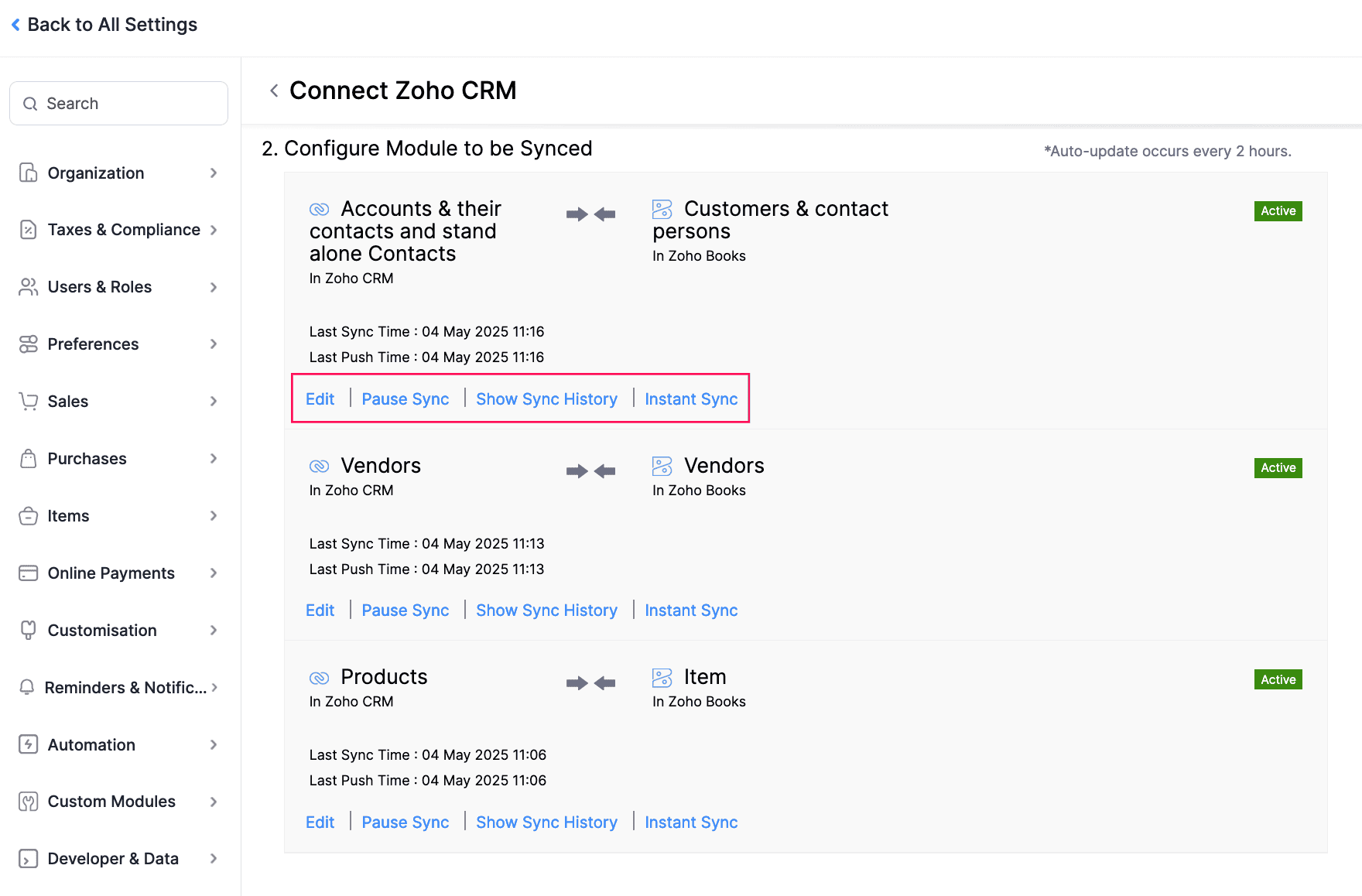
Note: If you’ve created a record in Zoho Books, synced it to Zoho CRM, and then deleted the record in Zoho CRM, the respective record will not be deleted in Zoho Books. Refer this FAQ.
Working With the Integration in Zoho Books
Once you set up the integration, you can perform the following actions in Zoho Books:
Access Zoho CRM Customers and Vendors
Depending on how you choose to sync records, the accounts, contacts, and vendors from Zoho CRM will be available as Customers and Vendors in Zoho Books.
Filter by CRM Customers and Vendors
You can view all the accounts and contacts synced from Zoho CRM into Zoho Books as Customers. Here’s how:
Go to Sales on the left sidebar and select Customers.
Click the All Customers filter at the top of the page and select CRM Customers from the dropdown.
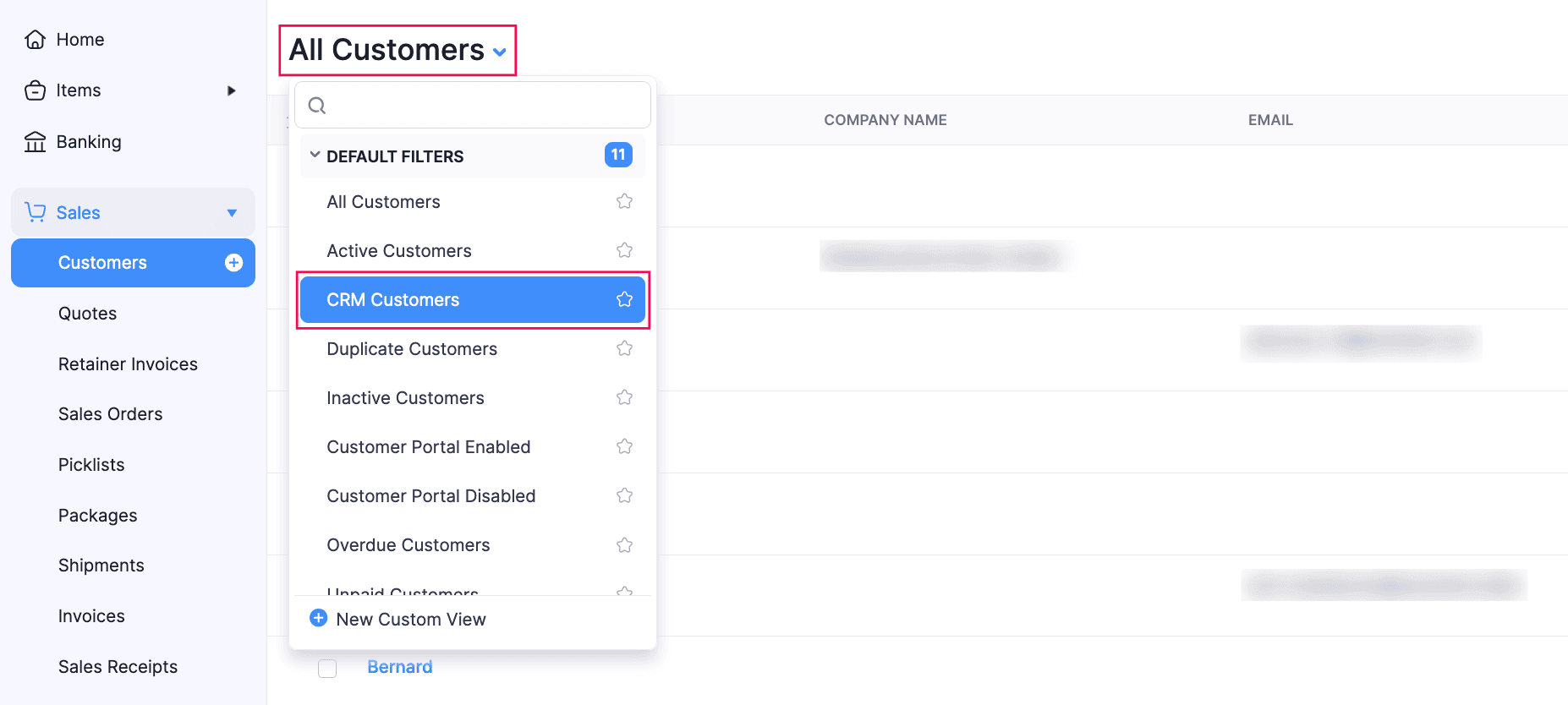
The respective CRM accounts and contacts will be displayed. Similarly, you can filter the CRM vendors in the Vendors module.
Search CRM Customers and Vendors
The customers and vendors fetched from Zoho CRM will be available in Zoho Books, and you can create transactions for them. However, you can also create transactions for customers and vendors not yet imported. Here’s how:
Select a transaction you want to create (for example, Invoices).
Click + New in the top right corner of the page.
In the New Invoice page, click the Advanced Customer Search icon in the Customer Name field.
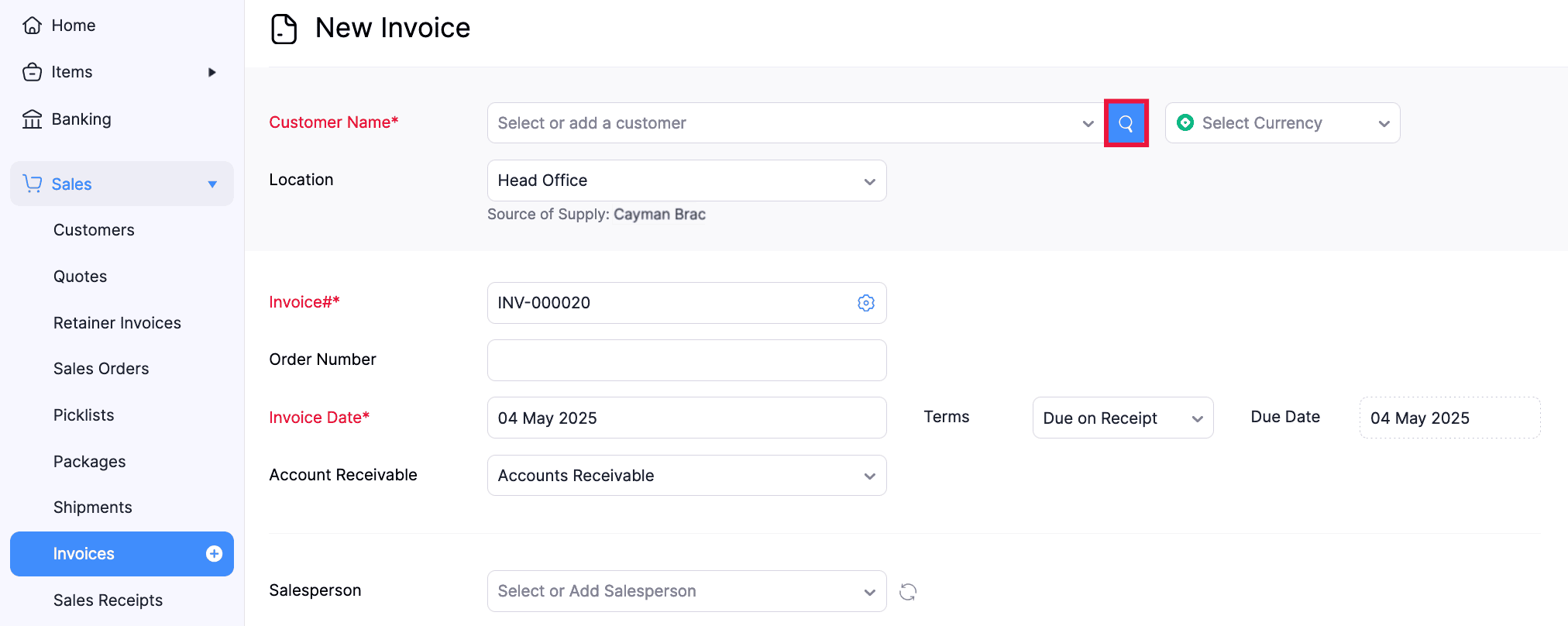
In the Advanced Customer Search pop-up, the list of customers from Zoho Books and Zoho CRM will be displayed. Select Zoho CRM at the top of the pop-up.
Enter the Account Name and click Search.
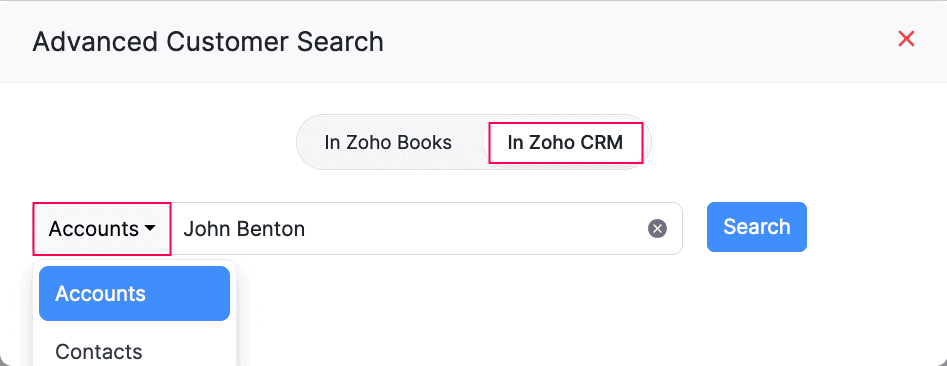
A list of contacts and accounts associated with the entered account name will be displayed. Select the required contact or account from the list.
Once done, the selected account or contact will be fetched as a customer in Zoho Books. Now, you can create sales transactions for them.
Insight: f you want to search contacts, the available Search Criteria are First Name and Last Name. If you want to search for accounts, enter the account name from Zoho CRM. The contacts associated with the respective account will be displayed.
Similarly, you can create purchase transactions for vendors that haven’t been fetched from Zoho CRM yet.
Associate Potentials With Transactions
Prerequisites:
- Ensure that the Zoho Finance modules (Invoices, Quotes, Sales Orders, and Purchase Orders) are enabled in your Zoho CRM account.
- Verify that the deal is associated with the correct account or customer in Zoho CRM.
Once you integrate Zoho Books with Zoho CRM, you can associate potentials in Zoho CRM with quotes, sales orders, invoices, and expenses in Zoho Books.
To associate a potential with an invoice:
Go to Sales on the left sidebar and select Invoices.
Click + New in the top right corner of the page.
- If you want to associate a potential with an existing invoice, select the required invoice, and click Edit at the top of the customer’s Details page.
In the next page, click the Associate Potential field.
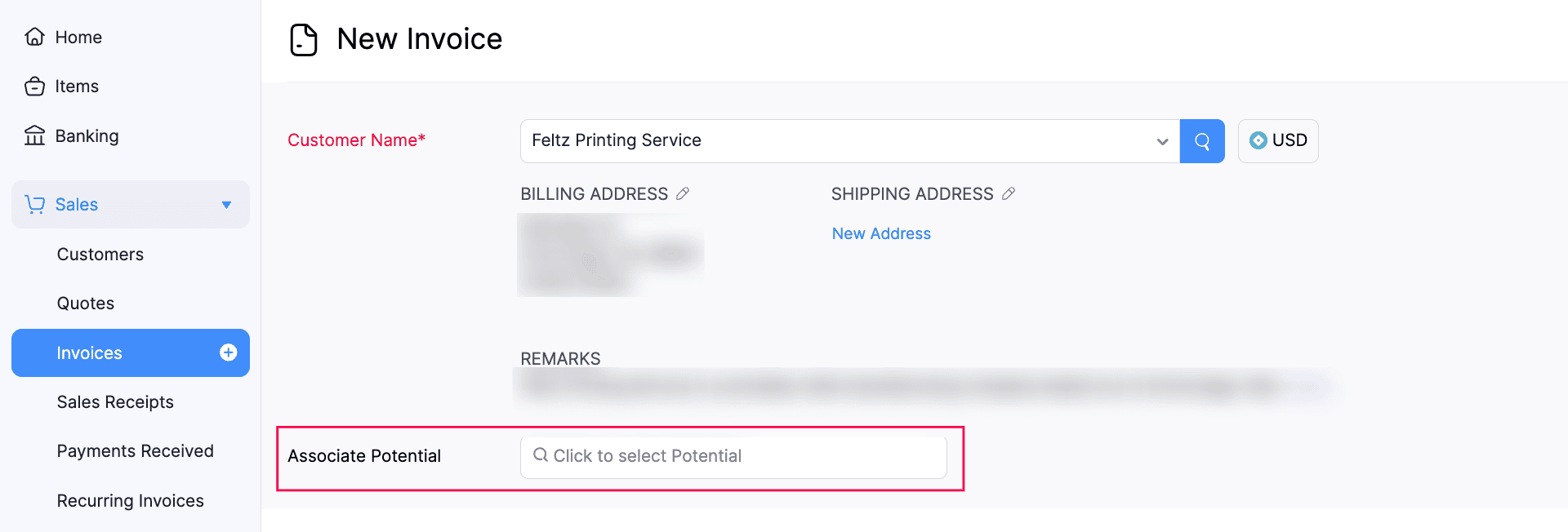
In the Potentials pop-up, select the required potential you wish to associate with the transaction.

The potential will be associated with the respective invoice, and you can create and record it in Zoho Books.
Pro Tip: To view this transaction in your Zoho CRM account, select the potential and scroll down to the Zoho Finance section.
Insight: If there are multiple potentials associated with a customer or if you can’t find the required potential, you can search for them. However, deleted potentials in Zoho CRM will not appear in the search results.
Dissociate Potentials
To dissociate a potential:
Go to the respective transaction, and click Edit at the top of the transaction’s Details page.
In the next page, remove the potential from the Associate Potential field.
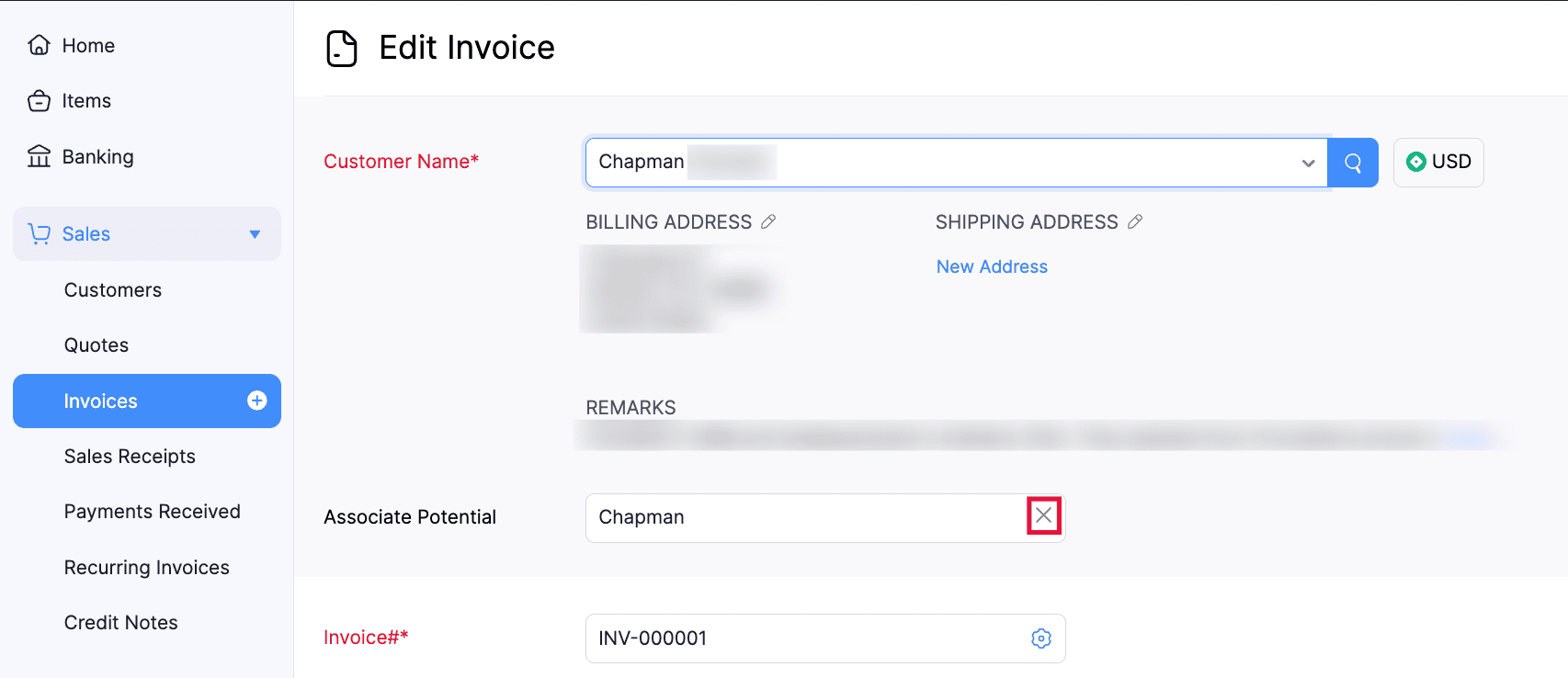
The potential will be dissociated.
Warning: Potentials that were associated using triggers cannot be dissociated.
Working with the Integration in Zoho CRM
When you integrate Zoho Books with Zoho CRM, you can sync records between both apps and manage them directly from Zoho CRM. Read more to learn about the actions you can perform in Zoho CRM.
Disable Integration
If you do not want to sync records between Zoho Books and Zoho CRM, you can disable it temporarily.
Warning: If you’ve enabled syncing of transaction modules, disabling the integration will delete any custom reports, comments, and attachments associated with transactions in the Zoho Finance module of Zoho CRM. However, your existing transactions in Zoho Books will remain unaffected.
To disable the integration:
Go to Settings.
Select Zoho Apps under Integrations & Marketplace.
In the Zoho Apps page, click Show Details next to Zoho CRM.
Click Disable Integration in the Zoho CRM Organization section.
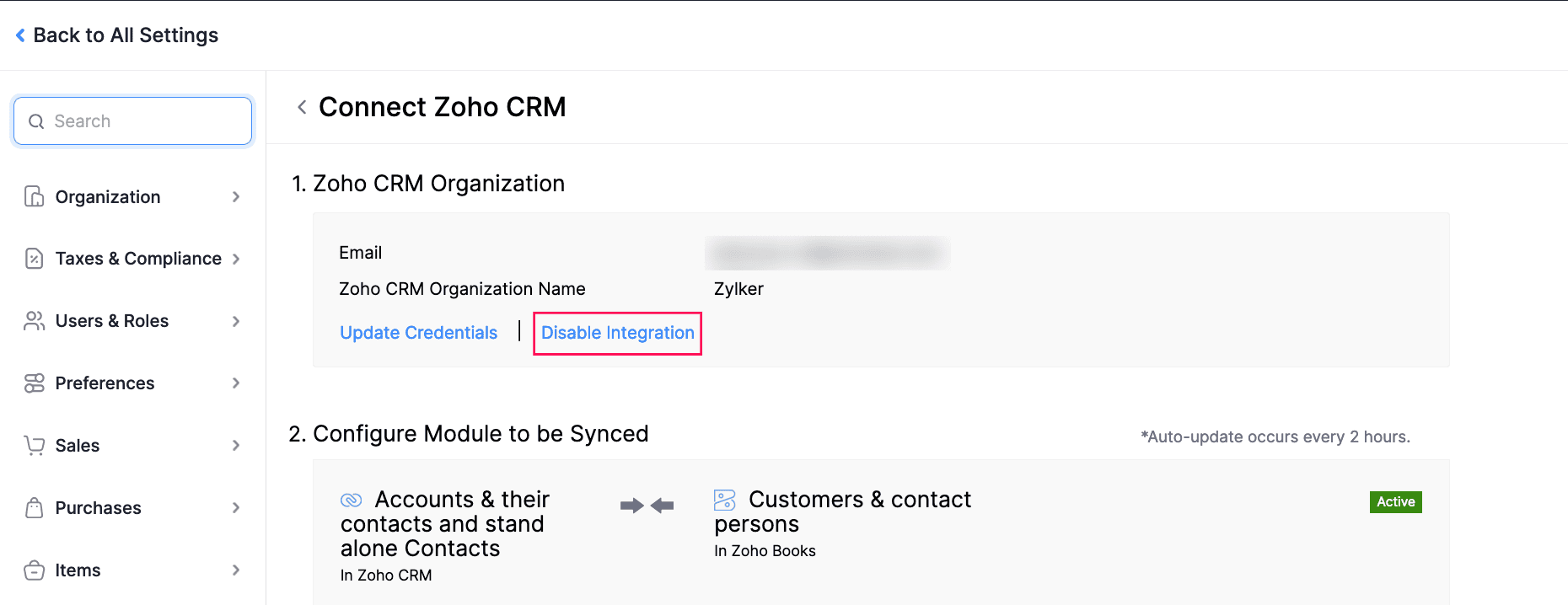
In the pop-up that appears, click Confirm.
The integration between Zoho CRM and Zoho Books will be temporarily disabled. To re-enable the integration:
- Go to Settings.
- Select Zoho Apps under Integrations & Marketplace.
- In the Zoho Apps page, click Show Details next to Zoho CRM.
- Click Enable Integration in the Zoho CRM Organization section.
- In the pop-up that appears, click Confirm.
- In the Connect Zoho CRM pop-up, check the Organization you want to sync, and click Save.
The integration will be enabled again, and data will be synced from Zoho CRM into Zoho Books.
Delete Integration
If you’ve disabled the integration between Zoho Books and Zoho CRM and no longer want to sync records, you can delete the integration. Once deleted, the mapping between the records will be permanently removed. This action cannot be undone. If you’ve integrated your Zoho Books organization with other Zoho Finance apps, the integration will be removed from those apps as well.
Prerequisite: You can delete the integration only if it is disabled.
To delete the integration:
Go to Settings.
Select Zoho Apps under Integrations and Marketplace.
Click Show Details next to Zoho CRM.
Click Delete Integration in the Zoho CRM Organization section.

In the pop-up, select if you want to convert all synced Zoho CRM records to Zoho Books records, or convert only the records with transactions and delete the remaining records.
Click Delete to confirm.
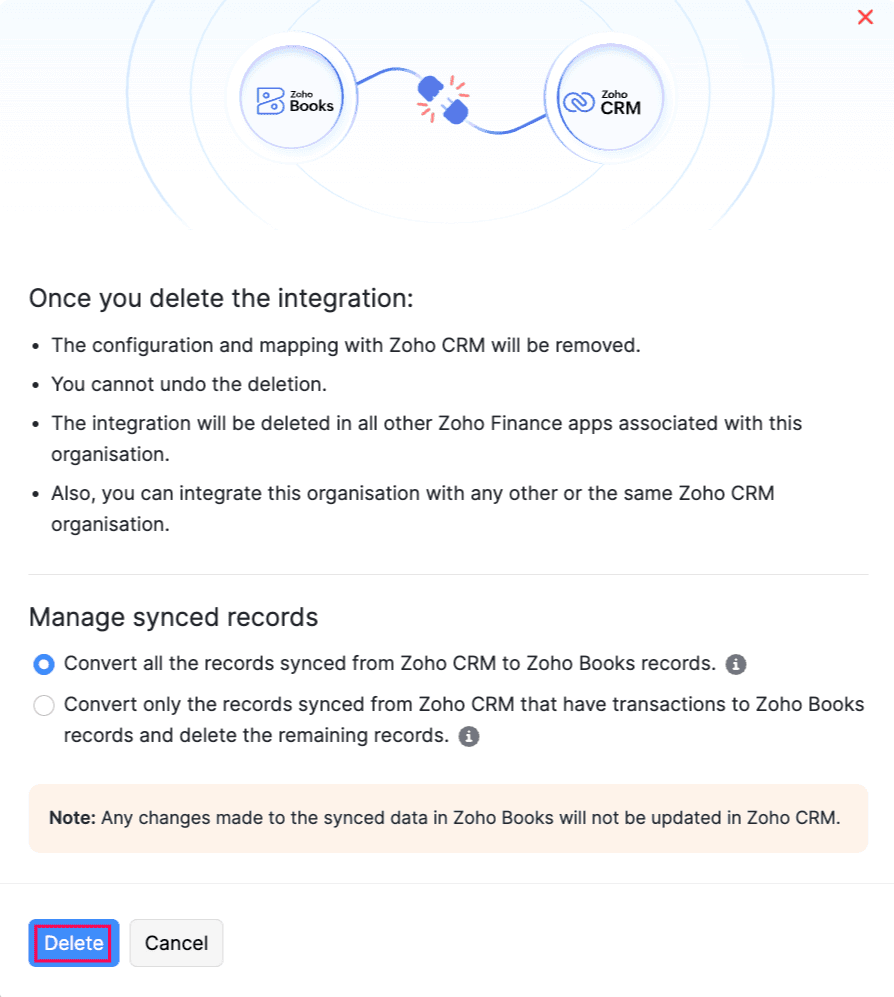
The integration will be deleted. You’ll also receive an in-app notification when the deletion is complete.


 Yes
Yes